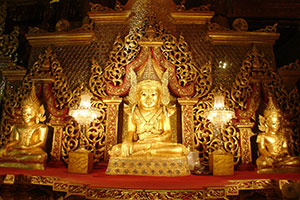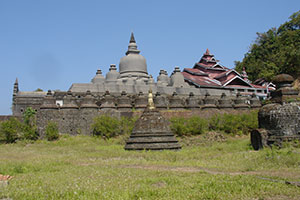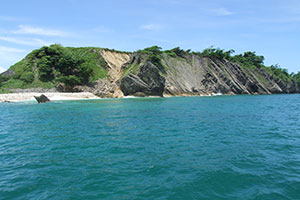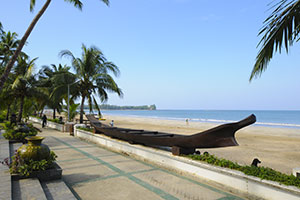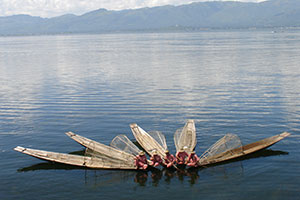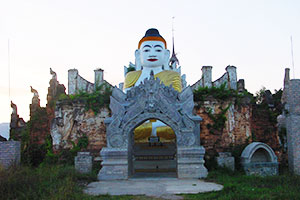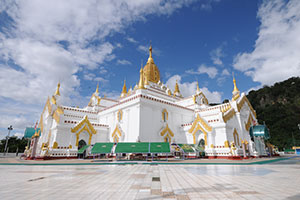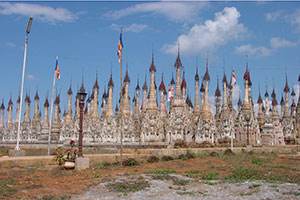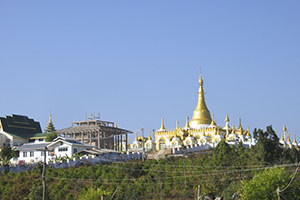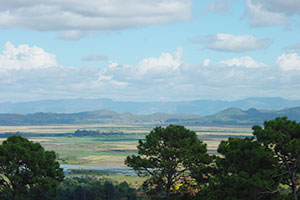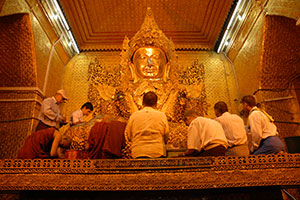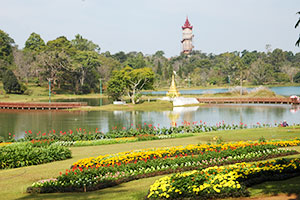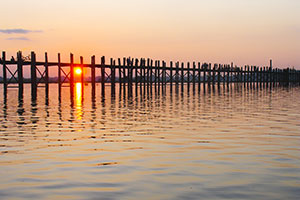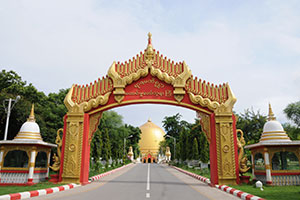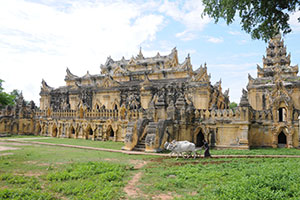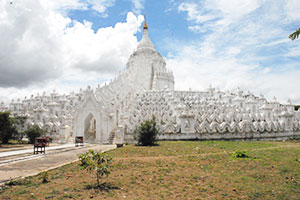Yangon
Yangon, the capital city of Myanmar, is so evergreen and cool with lush tropical trees, shady parks and beautiful lakes it has earned the name of "The Garden City of the East". Though with the atmosphere of a typical Asian city, It stands out in contrast as it is not yet overwhelmed with the global trends of modernity and is making its own progress at its own pace, in its own calm, civic culture. Being the main entrance to the country and principle seaport, it is the hub of business activities and government offices as well as non-governmental organizations.
It also serves as the center for higher learning as it abounds with educational institutions. The city represents a mixture of diverse communities and cultures, with respect to people, religion, business, and settlement. Yangon was founded by King Alaungpaya on the site of a small town called Dagon when he conquered lower Myanmar in 1755. He changed its name to Yangon, which means "End of Strife", but was anglicized as Rangoon by the British when they annexed Myanmar in 1885. The present day Yangon covers an area of 350 sq. km with a population of over 5 million.
The Shwedagon Pagoda
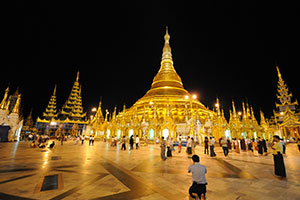 Towering to a height of 326 feet on Theingottara hill, dominates Yangon. Visitors to Myanmar are awe-struck on seeing the magnificence and splendor of this golden shrine. Ralph Fitch, the first Englishman to arrive in Myanmar's in 1558, comment: " it is called Dagon and is of a wonderful bigness, and all gilded from the foot to the topped - it is the fairest place, as I suppose, that is in the world." Rudyard Kipling inscribed "this most famous of all Myanmar shrines as a golden mystery lofty on the horizon, a beautiful wonder that blazed in the sun," in his letters from the east published in 1889. In his Gentleman in the Parlor, Somerset Maugham, at his first sight of the Pagoda was inspired to write that the superb, glistening, golden Shwedagon rising superbly upwards, was ". Like a sudden hope in the dark night of the soul. The great golden Shwedagon Pagoda is the prominent landmark visible from miles around, where the holy hair relics of the Buddha were enshrined more than 2,500 years ago. It is one of the wonders of the world and the most venerable pagoda in Southeast Asia.
Towering to a height of 326 feet on Theingottara hill, dominates Yangon. Visitors to Myanmar are awe-struck on seeing the magnificence and splendor of this golden shrine. Ralph Fitch, the first Englishman to arrive in Myanmar's in 1558, comment: " it is called Dagon and is of a wonderful bigness, and all gilded from the foot to the topped - it is the fairest place, as I suppose, that is in the world." Rudyard Kipling inscribed "this most famous of all Myanmar shrines as a golden mystery lofty on the horizon, a beautiful wonder that blazed in the sun," in his letters from the east published in 1889. In his Gentleman in the Parlor, Somerset Maugham, at his first sight of the Pagoda was inspired to write that the superb, glistening, golden Shwedagon rising superbly upwards, was ". Like a sudden hope in the dark night of the soul. The great golden Shwedagon Pagoda is the prominent landmark visible from miles around, where the holy hair relics of the Buddha were enshrined more than 2,500 years ago. It is one of the wonders of the world and the most venerable pagoda in Southeast Asia.
Karaweik Hall
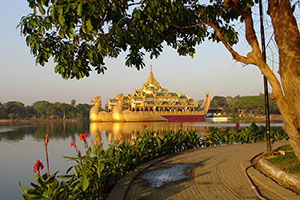 Karaweik Hall is one of the landmarks of Yangon, standing in the Kandawgyi Lake(Royal Lake ). This modern architecture is built in the shape of the mythical creature Karaweik bird. It has 3 floors including a ceremonial hall. This wholly gilded building is about 20 years old.
Karaweik Hall is one of the landmarks of Yangon, standing in the Kandawgyi Lake(Royal Lake ). This modern architecture is built in the shape of the mythical creature Karaweik bird. It has 3 floors including a ceremonial hall. This wholly gilded building is about 20 years old.
The colonial buildings in and around Yangon
In Yangon there remains quite a number of old buildings built in the time of British occupation. These remind us of former British’s presence in Myanmar . They were constructed in the middle of 19th century, before the Second World War in 1940. The colonial residences are substantial castles built of brick, masonry and wood with the multi-gabled roofs, verandas and the porches. These English Style houses are seen in the shady and tranquil compounds in the downtown areas. The Yangon City hall , next to Sule Pagoda faces the Mahabandoola Park . To the East is the building of the Supreme Court. Painted in red, yellow color equally. That Victorian building was constructed between 1905 and 1911. A short distance to the west is the famous Strand hotel constructed in 1901. In those days the Oriental hotel in Bangkok and the Strand hotel in Yangon were among the best hotels in is the south Asia . Later, it was restored and furnished with modern facilities.
Advance to the west is the Office of Myanmar Harbor authority with an uprising tower in the Pansodan Street . And the Yangon Division court resembles Queen-Ann-Style English architecture. Other remarkable colonial style buildings are the Yangons station decorated with typical Myanmar traditional arts, the Mee Ya Htar building (used to be Myanma railway office) built of red brick in colonial architecture, the Bogyoke Aung San Market and the Holy Trinity Anglican Cathedral in the typical English colonial style painted in dominantly red color. All these structures are on Bogyoke Aung San Street , as is the Yangon General hospital, which was the first public building in Myanmar and was constructed in 1911. Constructs red brick equalized with yellow, this enormous structure characterizes a lot of large arches and appearing to turrets indistinctly. The other indubitable English time public building is Ministerial office, which occupies the whole block of land surrounded by Anawrahta, Thein Byu, Mahabandoola and Bo Aung Kyaw streets.
Bogyoke Aung San Market
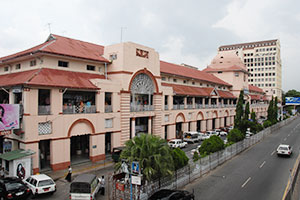
It is a fantastic prewar structure in Yangon known as Scott Market before. It is the most famous shopping place in Yangon . Myanmar arts and handicrafts are best souvenirs available there at reasonable price. Lacquer wares, wood and ivory carvings, tapestries, silverware, brassware, silk and cotton fabrics, and shoulder bags as well as jewelry are some of the most favorite items it has to offer.
Chaukhtatgyi Pagoda
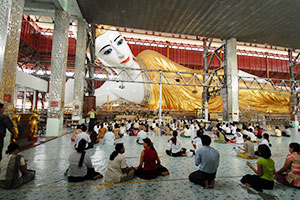
Located 10 minutes away from downtown, and 5 minutes from the famous Shwedagon Pagoda, the 72 meters long reclining Buddha image is the biggest colossal reclining Buddha image in Myanmar. Originally built in 1907, it has suffered damage due to climate over the years. In 1957, it was demolished and rebuilt to this structure and completed in 1966. The uniqueness of the image is the glass mosaic on the sole of its feet representing the 108 special characteristics of the Buddha.
Botahtaung Pagoda
It is a shrine with hollow passages inside to walk through. The name Botahtaung means "a thousand military leaders". This pagoda was named after the 1,000 military leaders who escorted the sacred hair relics of Buddha, brought from India over two thousand ago. Inside the pagoda, there are glass showcases containing many ancient relics and donated artifacts sealed but visible inside the shrine. The original shrine was destroyed during the World war II bombing. Present day structure is built over the old original one. Above this interesting interior, the golden pagoda spire rises to 132 feet (40 meters).
Hlawga Wildlife Park
Hlawga Park is about 45 minutes drive from downtown. The park covers 1,650 acres of land including the Hlawga Lake , which is a home for over 70 kinds of herbivorous animals and 90 species of birds. It has a museum of the replica of Myanmar traditional buildings and a small zoo with rock garden. Flocks of migratory birds frequently visit the park. It is an ideal place for picnickers, naturalists, botanists and bird-watchers. Visitor can also enjoy elephant rides, boating and fishing in the park.
Htaukkyant war cemetery
Located at Htaukkyant, about 32 km from Yangon on the road to Bago, there is a memorial cemetery of Allied soldiers who died in the Burma Campaign during World War II. The cemetery's beautifully kept compound has 27,000 tombstones of fallen Common Wealth and Allied soldiers.
Bogyoke Aung San Museum
A two-story -building where Burma ’s national independence leader General Aung San lived with his family until the time of his assassination was turned into museum in 1962. The furniture, dresses, books, the car and his family photos are kept in the same condition, as he was alive in his memory.
Natural history Museum
Situated near the Kandawgyi Lake, the Natural History Museum has a notable collection of Myanmar's geographical, biological and archaeological diversity including flora and fauna, forest products, minerals and rocks.
National Museum
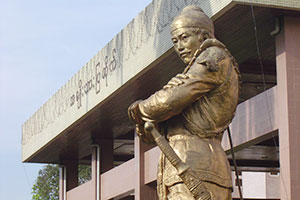
Located on Pyay Road, about a few minutes away from downtown, the newly built five-storied museum will let you know the glory of Myanmar. It exhibits the Lion Throne of the last Myanmar king, royal regalia of 19th century Myanmar kingdom, artifacts of various ancient periods, articles of cultural heritage and archaeological value, art and craft articles, weaponry, musical instruments and paintings.
Myanmar Gems Museum
Located on Kaba Aye Pagoda Road , Mayangon, Yangon . This Gems Mart display the whole range of Myanmar ruby, sapphire, Peridot and a variety of assorted colored stones, jade, pearls in lots or embedded in exquisite jewelry, gold ware, silverware and jade figurines. Out of 100 counters altogether, only two counters on the ground floor are occupied by the Myanmar Gems Enterprise and Myanmar VES Joint Venture Co., Ltd. The other 30 on the ground floor and 34 counters each on the first and second floors are run by private. These are sold in Myanmar Kyats, US$ or foreign exchange certificates (FEC).
Strand Jetty
The jetty is situated in front of the famous Strand Hotel. From there, you may observe the daily lives of people who came across the river from the other side of the city for working or selling their local products. You can cross the river by ferry boat, which takes about 10 minutes to return.
Sule Pagoda
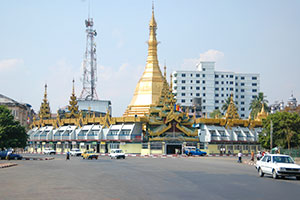
The landmark at the Yangon City center and symbol of downtown Yangon is situated right at the heart of the city. The Sule Pagoda is said to be over 2,000 years old, enshrining a hair relics of the Buddha. The golden pagoda is unusual in that its octagonal shape continues right up to the top terrace. It stands 46 meters (152 feet) high and is surrounded by small shops of all the familiar non-religious services such as astrologers, palmists, photo studios and watch repair. From there, you may observe the atmosphere of the Yangon center with crowed people from all walks of life in various trades, and busy traffic.
Kabar Aye Pagoda (World Peace Pagoda)
Locates about 20 minutes drive to the north of downtown. Built by U Nu, one of the earlier prime ministers of Myanmar not long after her independence from the British, in 1954 in dedication to the Sixth Buddhist Council (1954-56). This 111-feet-high pagoda measures 34 meters around the base.
Kyauktawgyi Pagoda
Lawka Chanthar Arbayar Laba Muni Buddha Image craved from the one piece of white is marble rock was done in year 2000 CE, which is flawless and of hight quality measuring 37 feet long, 24 feet wide and 11 feet thick was found at Sakyin Hill, Madaya Township, Mandalay Division. This huge Image is now at Mindhamma Hill, Insein Township, Yangon Division. This Buddha Image will be the highest and biggest of all in the world.
Zoological Garden
Located near the Kandawgyi Palace Hotel, the Yangon Zoo is noted for its collection of wild animals from around the world, rare species, flora and fauna, which have been collected over the years since it was opened in 1906. On weekends and public holidays, snake dance and elephant circus are performed for visitors. The Zoological Garden Amusement Park is also a well-known spot for children and teenagers.
Thanlyin (Syrium)

Once the center of foreign trade for all lower Myanmar. In 16th century Syrium was home to trading port of Portuguese, Dutch, French and British merchants. Later the Portuguese adventure de Brito established his own private kingdom. The ruin of a Catholic church built by an Italian missionary in the 18th century can still be seen today. During the colonial days the British have imported some one millions of Indian for rice cultivation. Syrium still host a great numbers of Indian population though Myanmar citizen but their customs and way of life are still very much determined by the Hindu religion.
Kyeikkhauk Pagoda
Yele Pagoda (a pagoda on a small island) at Kyauktan are worth visiting. You may also observe the local ways of making ceramic products at Bogyoke Village.
Twantay
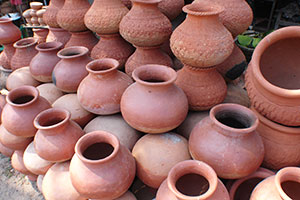
24 km from Yangon, reachable by road in an hour or by boat in about two hours on the Twantay Canal. The boat trip provides a view of the life along the canal while Twante itself provides interest as a center of pottery and hand-woven cotton cloth. There are over fifty pottery works. This craft has been handed down from generation to generation and is still carried on in the time-honored tradition. Twantay pottery is recognized and distributed throughout the country. Thousands of water pots flower pots, basins, jars of from 5 to 25 viss capacity are produced daily.
Bago
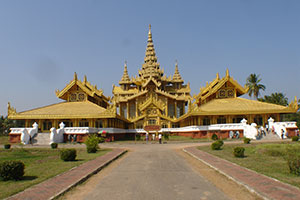
Do you want to see the country's highest golden pagoda? Or the Reclining Buddha 55 m in length and 16 m in height? Or Kyaukpun Pagoda's four huge seated Buddhas – sitting back to back facing the four points of the compass? Would you like to follow the studies of Buddha's teachings with the monks of Kyakhatwaing monastery? Or rather just stroll across and enjoy the extensive river market? Well, it is time to follow us to Bago. At a 2 hours´ drive from Yangon we visit the former capital of the Mon-People. We travel Myanmar's only “freeway”. While returning, you will have the chance to visit the temple (home of the nats according to local lore) dedicated to the guardian of traveling where motorists offer flowers to pray for a safe journey. Bago, called Pegu by the British and once an important sea harbour (before it silted up), has been reborn!
Kyaikhtiyo
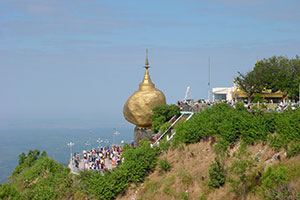
Reaching the Golden Rock 25 years ago meant a journey of several days on elephants´ back, nowadays the trip takes about 6 hours to Kinpun. This important venue for pilgrims is at the foot of a mountainous region and close to the Golden Rock. We leave Kinpun aboard pickups (sitting on small stools in the back) for a half hours´ steep climb and descend to reach the middle station with a more or less new hotel. From here it is a 1 hour’s climb by foot to reach the Golden Rock, where you pass the original hotel near the rock. Those not wanting to climb can hire a porter who takes them uphill in a bamboo chair. The reward is breathtaking: Way above the valley's jungles, reaching far beyond a cliff, the mighty rock, encrusted with gold leaves by faithful Buddhist pilgrims, its peak crowned by a small pagoda! A hair of the Buddha is said to be enshrined here. And it is this one hair that holds the huge boulder, perched on a cliff, from tumbling into the abyss below – the magic of believing!
Thaton
En route from the Golden Rock to Mawlamyine this now rather plain town was in its heyday the centre of the loosely connected Duchies of Dvaravati reaching from Thailand via Cambodia to the south of Burma and whose backbone were the Mon people. The implementation of Buddhism in Southeast Asia was the empire of Dvaravati´s great cultural accomplishment. Nearly 1000 years ago, this realm was defeated by the Burmese Bagan-King Anawratha, thus initiating the decline of the Mon. Fortunately spectacular monuments of the Mon culture persevered. In Thaton the golden pagoda Shwe Zayan and a Standing Buddha in superb Mon style remind us of their Golden Age which entered the annals as Suvannabhumi, Land of Gold.
Mawlamyine/Moulmein
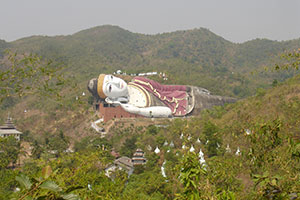
When the British established their Colony, Burma, in the 19th century, they made Moulmein their first capital and this explains the perseverance of its colonial charms to our days. Famous British authors wrote about its former grandeur. Today, Mawlamyine is number three in size among the cities of Myanmar, situated 270 km SE from the capital. The surrounding hills – crowned with pagodas – afford the best view of the city on the river Salween which here joins the Gulf of Martaban. The city also can be reached by ancient ferries which connect Mottama (Martaban) with Mawlamyine. The city is attractive and offers pagodas as well as churches for visits. Exploration of the surroundings show special sights such as the strategically relevant building site of the infamous “railroad of death” (to be reached via Kyaikhami/Amherst, about 60 km). Planned by the Japanese, this railroad was to connect Burma via Thailand with Singapore (The Bridge on the River Kwai). A well-tended cemetery for allied POWs working on and dying for this railroad reminds us of these grievous times. Along the way several remarkable pagodas as well as the building site near Mudon of a 160 m Reclining Buddha enhance these excursions. Moreover the ever close beaches beckon to rest …
Hpaan
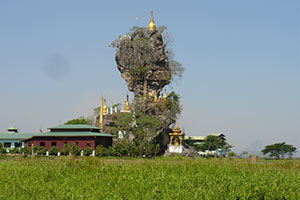
Hpaan, capital of Kayin State, is surrounded by lovely hills and mountains. This is perfect hiking country with its small lakes and many grottoes. Moreover taking time to enjoy the local market is a delightful experience. The colourful costumes of the Kayin women are a sight-to-be-seen. Hpaan is in between Mawlamyine and Yangon.
Pathein/Bassein
Looking at Pathein´s waterfront quays is living the past: Buildings of colonial times next to Chinese temples and Burmese pagodas, merchants offering their goods, street-stall-restaurants, sampans on water – what can be more exotic? Pathein, 180 km west of the capital, is – and always was – the “rice bowl” of the enormous Ayeyarwady river delta (300 kilometers wide), the stream who once was called Elephant River. Pathein is best reached by a comfortable ferryboat offering good cabins as accommodation for the night. The city is the gate to the beaches of Ngwe Saung (Silver Beach) and Chaungtha. Pathein can also be reached by bus after a long ride on bumpy roads! By the way: the much coveted Pathein Hti, colourful umbrellas to shade against the sun, is made in Pathein.
Pyay/Prome
In 1877 the British colonists built a railroad connection between Yangon and Pyay, formerly Prome. It was the first to be built in the erstwhile colony. Today we reach this important trade town on the shores of the Ayeyarwady after a drive of 5 hours. The city offers very little of tourist value, however, it is the gate for excursions to the ancient brick pagodas built by the Pyu people who vanished for a long time. They were part of the Sri Ksetra empire which existed in the 6th century AD, hence the pagodas of Sri Ksetra are the oldest in Myanmar and are among the oldest of the entire Buddhist world. Archaeologists have partly restored some of these pagodas and have thus come across Buddhist rock etchings as well as small Buddha statues which can be admired at the local museum.





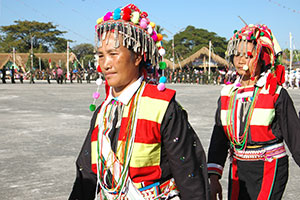
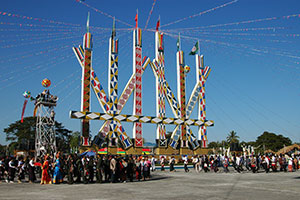
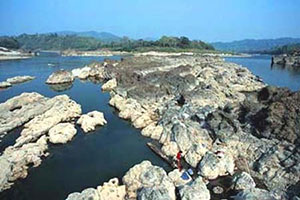
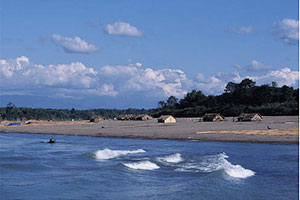
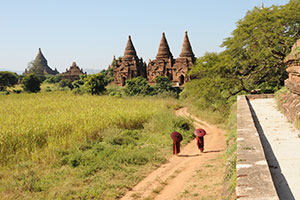
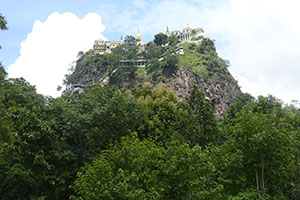
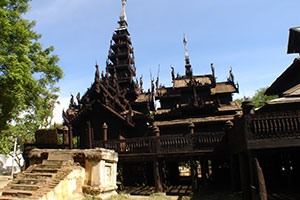
 Towering to a height of 326 feet on Theingottara hill, dominates Yangon. Visitors to Myanmar are awe-struck on seeing the magnificence and splendor of this golden shrine. Ralph Fitch, the first Englishman to arrive in Myanmar's in 1558, comment: " it is called Dagon and is of a wonderful bigness, and all gilded from the foot to the topped - it is the fairest place, as I suppose, that is in the world." Rudyard Kipling inscribed "this most famous of all Myanmar shrines as a golden mystery lofty on the horizon, a beautiful wonder that blazed in the sun," in his letters from the east published in 1889. In his Gentleman in the Parlor, Somerset Maugham, at his first sight of the Pagoda was inspired to write that the superb, glistening, golden Shwedagon rising superbly upwards, was ". Like a sudden hope in the dark night of the soul. The great golden Shwedagon Pagoda is the prominent landmark visible from miles around, where the holy hair relics of the Buddha were enshrined more than 2,500 years ago. It is one of the wonders of the world and the most venerable pagoda in Southeast Asia.
Towering to a height of 326 feet on Theingottara hill, dominates Yangon. Visitors to Myanmar are awe-struck on seeing the magnificence and splendor of this golden shrine. Ralph Fitch, the first Englishman to arrive in Myanmar's in 1558, comment: " it is called Dagon and is of a wonderful bigness, and all gilded from the foot to the topped - it is the fairest place, as I suppose, that is in the world." Rudyard Kipling inscribed "this most famous of all Myanmar shrines as a golden mystery lofty on the horizon, a beautiful wonder that blazed in the sun," in his letters from the east published in 1889. In his Gentleman in the Parlor, Somerset Maugham, at his first sight of the Pagoda was inspired to write that the superb, glistening, golden Shwedagon rising superbly upwards, was ". Like a sudden hope in the dark night of the soul. The great golden Shwedagon Pagoda is the prominent landmark visible from miles around, where the holy hair relics of the Buddha were enshrined more than 2,500 years ago. It is one of the wonders of the world and the most venerable pagoda in Southeast Asia. Karaweik Hall is one of the landmarks of Yangon, standing in the Kandawgyi Lake(Royal Lake ). This modern architecture is built in the shape of the mythical creature Karaweik bird. It has 3 floors including a ceremonial hall. This wholly gilded building is about 20 years old.
Karaweik Hall is one of the landmarks of Yangon, standing in the Kandawgyi Lake(Royal Lake ). This modern architecture is built in the shape of the mythical creature Karaweik bird. It has 3 floors including a ceremonial hall. This wholly gilded building is about 20 years old.









